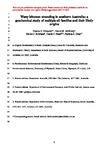Waxy bitumen stranding in southern Australia: a geochemical study of multiple oil families and their likely origins
| dc.contributor.author | Rowland, Steven | |
| dc.contributor.author | Edwards, DS | |
| dc.contributor.author | McKirdy, DM | |
| dc.contributor.author | Heath, DJ | |
| dc.contributor.author | Gray, PS | |
| dc.date.accessioned | 2018-03-12T12:27:32Z | |
| dc.date.available | 2018-03-12T12:27:32Z | |
| dc.date.issued | 2018-04 | |
| dc.identifier.issn | 0146-6380 | |
| dc.identifier.issn | 1873-5290 | |
| dc.identifier.uri | http://hdl.handle.net/10026.1/11071 | |
| dc.description.abstract |
Reports of bitumen stranding on the ocean beaches of southern Australia date back to the early days of European settlement. Previous investigations have shown that this ‘coastal bitumen’ comprises three categories of stranded petroleum: waxy bitumen, asphaltite and oil slicks. All three varieties are physically and chemically distinct from each other, and bear no geochemical resemblance to any indigenous Australian crude oil. This study focuses on the most common variety, waxy bitumen, which accounted for 90% of the strandings on six South Australian beaches repeatedly surveyed during 1991–1992. Geochemical analysis of 96 individual specimens collected from these survey sites and other beaches in South Australia and western Victoria has shown them to be variously weathered high-wax crude oils of paraffinic to aromatic-intermediate bulk composition. Elemental, isotopic and biomarker differences allow their assignment to at least five oil families with inferred source facies that range from deep freshwater lacustrine through paludal and deltaic to euxinic marine, possibly deposited within different sedimentary basins. Family 1, 2 and 3 waxy bitumens all contain biomarkers derived from the freshwater alga Botryococcus sp. and tropical angiosperms (notably dipterocarps). Similar biomarker assemblages are unknown in Australian sedimentary basins but are common in Cenozoic crude oils and source rocks throughout western Indonesia. Family 4 waxy bitumens lack these biomarkers, but do contain dinosterane and 24-n-propylcholestane, indicative of a marine source affinity, while the carbon isotopic signatures and high pristane/phytane (Pr/Ph) ratios of Family 5 waxy bitumens are consistent with their origin from coal-rich source rocks deposited in fluvial to deltaic sedimentary successions. The majority of these waxy bitumens represent an oceanic influx of non-indigenous, Southeast Asian crude oils carried into the waters of southern Australia by the Leeuwin Current. Although they are likely to originate from natural seepage within the Indonesian Archipelago, it is unknown whether the parent oils emanate from submarine seeps or from inland seepages which are then carried to the sea by rivers. The common practice of tanker cleaning operations in the Java and Banda seas may augment the supply of natural bitumen to the beaches of Australia. | |
| dc.format.extent | 132-151 | |
| dc.language | en | |
| dc.language.iso | en | |
| dc.publisher | Elsevier | |
| dc.subject | Waxy bitumen | |
| dc.subject | Southern Australia | |
| dc.subject | Biomarker alkanes | |
| dc.subject | Carbon isotopic signatures | |
| dc.subject | Oil families | |
| dc.subject | Ocean transport | |
| dc.subject | Indonesian provenance | |
| dc.title | Waxy bitumen stranding in southern Australia: a geochemical study of multiple oil families and their likely origins | |
| dc.type | journal-article | |
| dc.type | Journal Article | |
| plymouth.author-url | https://www.webofscience.com/api/gateway?GWVersion=2&SrcApp=PARTNER_APP&SrcAuth=LinksAMR&KeyUT=WOS:000428997900013&DestLinkType=FullRecord&DestApp=ALL_WOS&UsrCustomerID=11bb513d99f797142bcfeffcc58ea008 | |
| plymouth.volume | 118 | |
| plymouth.publication-status | Published | |
| plymouth.journal | Organic Geochemistry | |
| dc.identifier.doi | 10.1016/j.orggeochem.2017.12.010 | |
| plymouth.organisational-group | /Plymouth | |
| plymouth.organisational-group | /Plymouth/Faculty of Science and Engineering | |
| plymouth.organisational-group | /Plymouth/Research Groups | |
| plymouth.organisational-group | /Plymouth/Research Groups/Marine Institute | |
| plymouth.organisational-group | /Plymouth/Users by role | |
| dcterms.dateAccepted | 2017-12-21 | |
| dc.identifier.eissn | 1873-5290 | |
| dc.rights.embargoperiod | Not known | |
| rioxxterms.version | Accepted Manuscript | |
| rioxxterms.versionofrecord | 10.1016/j.orggeochem.2017.12.010 | |
| rioxxterms.licenseref.uri | http://www.rioxx.net/licenses/all-rights-reserved | |
| rioxxterms.licenseref.startdate | 2018-04 | |
| rioxxterms.type | Journal Article/Review |


